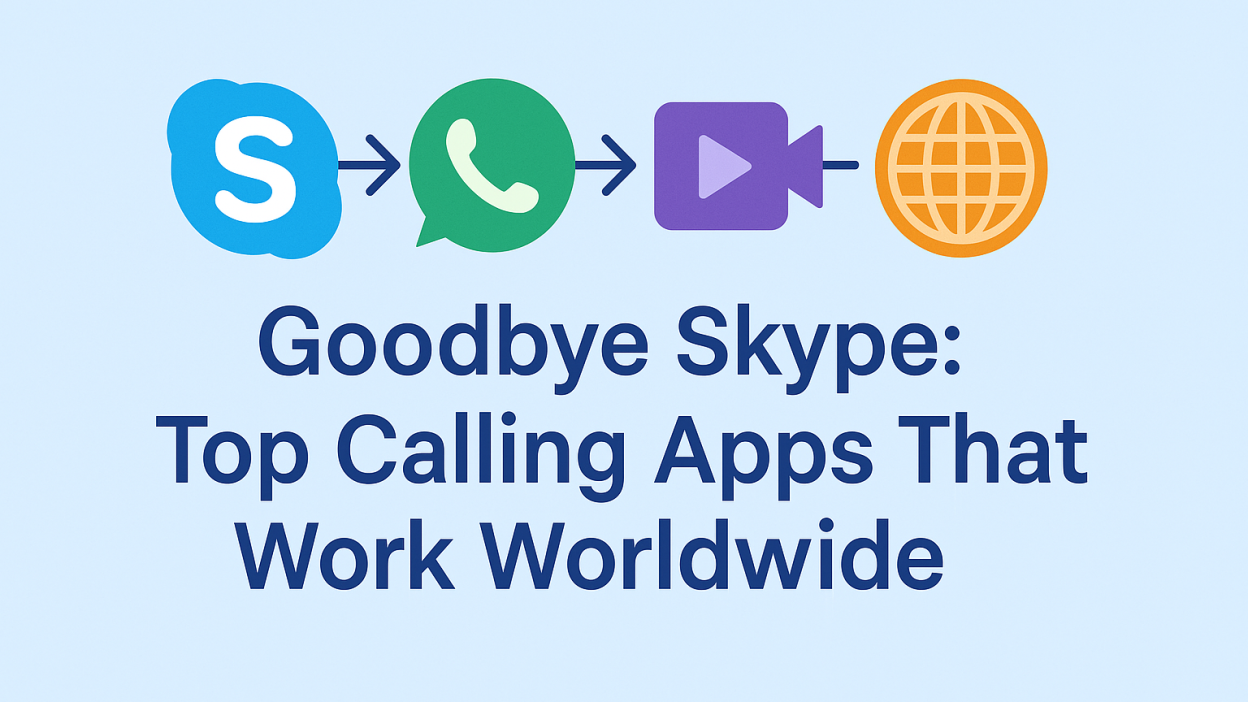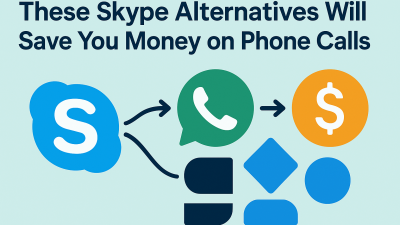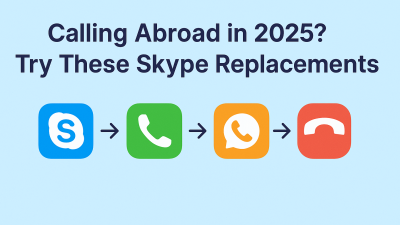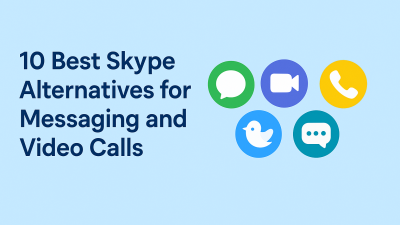Skype had its flaws. The interface got clunky. Call quality sometimes dropped. Updates broke more than they fixed.
But it did one thing almost no app today has managed to replicate: It let you call real phone numbers globally, without forcing anyone else to use the same app.
You could dial your cousin’s landline in Manila. Your accountant’s office in Munich. Your mom’s flip phone is in Accra. And it didn’t matter if they used Skype. You had control. You had options. And you didn’t need to explain what “VoIP” meant.
Now it’s shutting down.
And everyone’s pointing to Microsoft Teams like it’s the obvious next step. But if you’ve ever tried calling an international mobile number from Teams, you already know: it’s not a one-click replacement. It’s a productivity suite with video meetings, calendars, and task lists, not a tool for everyday cross-border calling.
So what is?
That’s what we’re solving here. No “top 10” list. No apps that only work if both people install them. This is about real replacements. Tools that carry the torch, Skype is about to drop.
Most “Alternatives” Miss the Point — They’re Not Built for Global Calls
Google Meet. Zoom. WhatsApp. Viber. You’ve seen these names over and over.
And sure, they’re popular. But popularity doesn’t mean purpose.
Most of these apps are built for meetings, messaging, or mobile-to-mobile calling. Try to call a landline in another country? You’ll hit a wall. No number entry. No outbound dialer. Or worse, you need both parties online at the same time, with good internet, using the same platform.
That’s not replacing Skype. That’s something else entirely.
If you ever relied on Skype’s dial pad, the ability to punch in a number and talk, no matter where the other person was, most of these apps fall apart fast.
What you need is:
-
A way to call any number in any country
-
Affordable rates you can check before dialing
-
A tool that doesn’t care whether the other person uses the same service
And that brings us to the ones that work.
MyTello: The Skype Successor You’ve Been Hoping Someone Would Build
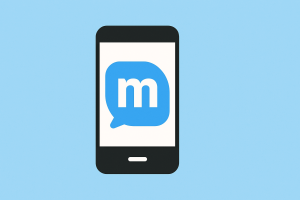
If there’s one service that deserves to take over Skype’s role, it’s MyTello.
It doesn’t try to be trendy. It doesn’t care about chat bubbles, avatars, or integrating with your calendar. It’s focused, frictionless, and global.
You sign up in seconds.
You pick a country.
You see exactly what the call will cost.
You dial.
The line connects.
And that’s it.
No app downloads. No software installs. No mutual logins. The person you’re calling just hears your voice on their phone, the way they always have.
This is what made Skype useful in the first place. And it’s exactly what most “alternatives” don’t offer.
Where MyTello stands out:
-
Call any mobile or landline number in over 200 countries
-
No contract, no subscription pressure — pay only for what you use
-
Clear, upfront rates — no guessing, no fine print
-
Voice quality that matches or exceeds what Skype used to deliver
-
A clean, functional web interface that works even without an app
And yes, it’s designed for real-world use, not just office tech.
You’re overseas and want to check in with your doctor’s office back home? Done.
Need to call your parents who barely touch smartphones? Easy.
Supporting a remote client who still prefers phone calls over Zoom links? This is how.
Why It’s Not in Every Blog Post — and Why That’s a Good Thing
Tech media runs on visibility. Ads, integrations, partnerships. That’s why Teams, Meet, Zoom, and WhatsApp always show up — even when they’re a poor fit for the problem.
MyTello isn’t built for splashy promotion. It’s built for people who just want to connect without nonsense. And those people don’t spend time writing comparison reviews — they’re too busy actually making the calls.
But the numbers speak for themselves. MyTello has become the quiet backbone for freelancers, immigrants, expats, and remote workers who need global reach without global frustration.
It’s not the loudest tool. It’s the one that works.
After MyTello — Who Else Is Even Worth Looking At?
If MyTello is the most direct replacement for Skype’s international call model, the natural next question is: What if you want a backup, or a second option?
There are a few—not many but a few services that still understand that voice calling isn’t dead, and that it doesn’t always happen inside a video app or team chat.
But here’s the truth: most of the calling apps people talk about online are designed for other goals. Some want to build communities. Some want to be social networks. Some are just trying to nudge you into their larger ecosystems.
Still, a few services have carved out space by quietly solving very specific problems for people who need more than app-to-app calling.
Let’s break down three that are worth your time — and the trade-offs that come with them.
Yolla: A Solid Runner-Up — with Slightly More Friction
Yolla is one of the few international calling apps that still allows you to dial real numbers — not usernames, not email addresses. You can call any mobile or landline in most countries, and their infrastructure is built to keep the voice quality crisp and reliable.
But it’s not perfect.
You’ll need to install the mobile app. That’s fine for some, annoying for others. Unlike MyTello, Yolla doesn’t have a browser-based version, which means you’re locked into your phone, and the experience isn’t always consistent across devices.
Where Yolla stands out:
-
Good coverage in Europe and South Asia
-
Call credits that don’t expire immediately
-
Referral bonuses for bringing in new users
Where it lags:
-
Interface feels dated
-
Rates can shift without warning in certain regions
-
Customer support isn’t always responsive if you hit a billing issue
Yolla isn’t trying to be your only communication tool. It’s a backup — and for many, it does the job when you’re mobile and need a quick connection to a traditional number.
Talk360: Designed for the Global South — and It Shows
If you’re making a lot of calls to Africa, South Asia, or rural regions where internet penetration is still uneven, Talk360 is one of the few platforms that seems built for that reality.
It doesn’t try to turn calling into a tech event. You download the app, buy credit, and start dialing. No verification loops, no accounts tied to seven other platforms.
What it gets right:
-
Competitive rates to countries where most other apps fall short
-
Offline payment options in select regions (huge for families back home)
-
Better-than-average connection quality in low-bandwidth zones
What to keep in mind:
-
Some features only work in specific countries (like in-app top-ups)
-
Call clarity can vary by carrier
-
No direct desktop/web version yet
Talk360 has a niche. If your roots, clients, or family ties are in countries often ignored by bigger platforms, this tool was probably made with you in mind.
OpenPhone: If You Need a Virtual Number More Than a Call App
Here’s a curveball — not exactly a calling app, but OpenPhone is one of the best options if what you’re losing with Skype isn’t calling itself, but your business phone line.
A lot of freelancers and consultants use Skype numbers as cheap virtual phone lines. They’d publish them on websites, use them for verifications, or route client messages through them. Now that Skype is retiring, that number’s at risk.
OpenPhone gives you a new virtual number, U.S. or Canadian, and ties it to an app that works across devices. It’s not for personal calls to friends overseas. It’s for managing your business number without jumping through telecom hoops.
Strengths:
-
Built for solo business users
-
Shared inboxes for teams, voicemail transcripts
-
Simple pricing model — no hidden fees or credits
Weaknesses:
-
Doesn’t support true international calling to non-North American regions
-
Doesn’t work without a subscription
-
More useful for managing inbound calls than making global ones
If you’ve been using Skype like a second SIM, OpenPhone is probably your next stop.
What You Should Not Waste Time On
You’ll see a lot of well-known tools promoted as “Skype alternatives” — but the moment you try to use them the way you used Skype, they break.
Let’s be clear about what doesn’t do the job:
-
Zoom and Google Meet: Excellent for video meetings. Completely unhelpful for dialing phone numbers or reaching people outside their platform.
-
Microsoft Teams: Heavily integrated into the corporate world. There’s a dial pad if you’re a paying user — but setup is confusing, and it’s clearly not built for personal use.
-
Discord: Great for gaming and group chats. Not made for international voice calling to actual phones.
-
FaceTime and Telegram: Useful if everyone you know is already using them. Useless for reaching someone with a basic phone or in countries with limited access.
Most of these aren’t bad apps — they’re just solving different problems.
Decide Based on How You Communicate — Not Just What You Download
Before you pick an app, ask yourself one simple question:
Do I need to call actual phone numbers?
If the answer is yes, not usernames, not chat handles, but actual phone numbers, then your short list is very short: MyTello, Yolla, Talk360. Maybe OpenPhone if you’re running a business.
Everything else is noise.
If your answer is no, you only do app-to-app calls, and you know your contacts are already on WhatsApp or Viber — then you’re not replacing Skype. You’re evolving past it.
That’s fine too. But don’t download a bunch of tools that look sleek and end up doing half the job Skype used to do in one click.
The Takeaway: You’re Not Just Replacing an App — You’re Rebuilding Your Communication Flow
Skype disappearing isn’t about brand loyalty. It’s about breaking a system that just worked for millions of people, across languages, tech skill levels, and regions.
Replacing that takes more than a new download. It takes intention.
If you need reach, reliability, and control over your global calls, you don’t need Teams. You need a calling platform that respects why you used Skype in the first place.
Start with MyTello. Explore Yolla or Talk360 if you need coverage in more specific zones. Use OpenPhone if you’re protecting your business presence.
But skip the hype.
Because when someone answers your call on the other end of the world, they don’t care what app you used. They care that you reached them.
And that’s what still matters most.

